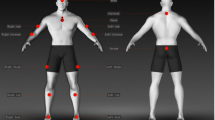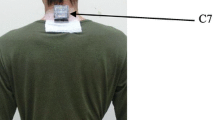Abstract
For persons with multiple sclerosis (MS), the general decline in neuromuscular function underlies diminished balance, impaired gait and consequently, increased risk of falling. During gait, optimal control of head motion is an important feature which is achieved partly through control of the trunk-neck region to dampen gait-related oscillations. The primary aim of this study was to examine the effect performing a 6-minute walk test (6MWT) has on head, neck and trunk accelerations in individuals with MS. This was addressed using a repeated measures generalized linear model. We were also interested in assessing whether the 6MWT has an impact on a person’s falls risk and specific physiological measures related to falls. Finally the relation between the amplitude (i.e., mean RMS) of head and trunk accelerations and falls risk was examined using linear regression. The main results were that over the course of the 6MWT, individuals progressively slowed down coupled with a concurrent increase in gait-related upper body accelerations (p’s > 0.05). Despite the increased acceleration, no significant changes in attenuation from the trunk to the head were observed, indicating that persons were able to maintain an optimal level of control over these oscillations. Performing the 6MWT also had a negative impact on posture, with falls risk significantly increasing following this test (p > 0.05). Interestingly, the overall falls risk values were strongly linked with vertical accelerations about the trunk and head, but not average walking speed during the 6MWT. Overall, performing the 6MWT leads to changes in walking speed, upper body acceleration patterns and increases in overall falls risk.





Similar content being viewed by others
References
Amboni M, Barone P, Hausdorff JM (2013) Cognitive contributions to gait and falls: evidence and implications. Mov Disord 28:1520–1533
Barr C et al (2014) Walking for six minutes increases both simple reaction time and stepping reaction time in moderately disabled people with multiple sclerosis. Mult Scler Relat Disord 3:457–462
Bogen B et al (2019) Two-year changes in gait variability in community-living older adults. Gait Posture 72:142–147
Burschka JM et al (2012) An exploration of impaired walking dynamics and fatigue in multiple sclerosis. BMC Neurol 12:161
Caetano MJD et al (2018) Stepping reaction time and gait adaptability are significantly impaired in people with Parkinson’s disease: Implications for fall risk. Parkinsonism Relat Disord 47:32–38
Cameron MH, Lord S (2010) Postural control in multiple sclerosis: implications for fall prevention. Curr Neurol Neurosci Rep 10:407–412
Cattaneo D et al (2002) Risks of falls in subjects with multiple sclerosis. Arch Phys Med Rehabil 83:864–867
Close JCT et al (2005) What is the role of falls? Best Pract Res Clin Rheumatol 19:913–935
Craig JJ et al (2017) The relationship between trunk and foot acceleration variability during walking shows minor changes in persons with multiple sclerosis. Clin Biomech (bristol, Avon) 49:16–21
Craig JJ, Bruetsch AP, Huisinga JM (2019) Coordination of trunk and foot acceleration during gait is affected by walking velocity and fall history in elderly adults. Aging Clin Exp Res 31:943–950
Craig JJ et al (2020) Trunk and foot acceleration variability during walking relates to fall history and clinical disability in persons with multiple sclerosis. Clin Biomech (bristol, Avon) 80:105100
Delval A et al (2020) Cortical oscillations during gait: wouldn’t walking be so automatic? Brain Sci 2020:10
Escudero-Uribe S, Hochsprung A, Izquierdo-Ayuso G (2019) Gait pattern changes after six-minute walk test in persons with multiple sclerosis. Physiother Res Int 24:e1741
Fasano A et al (2017) Falls in Parkinson’s disease: a complex and evolving picture. Mov Disord 32:1524–1536
Fritz NE et al (2015) The impact of dynamic balance measures on walking performance in multiple sclerosis. Neurorehabil Neural Repair 29:62–69
Goldman MD, Marrie RA, Cohen JA (2008) Evaluation of the six-minute walk in multiple sclerosis subjects and healthy controls. Mult Scler 14:383–390
Helbostad JL et al (2007) Physical fatigue affects gait characteristics in older persons. J Gerontol A Biol Sci Med Sci 62:1010–1015
Hoang PD et al (2014) Neuropsychological, balance, and mobility risk factors for falls in people with multiple sclerosis: a prospective cohort study. Arch Phys Med Rehabil 95:480–486
Hoang PD et al (2016) Fall risk in people with MS: a physiological profile assessment study. Mult Scler J Exp Transl Clin 2:2055217316641130
Hua A et al (2018) Accelerometer-based predictive models of fall risk in older women: a pilot study. NPJ Digit Med 1:25
Kavanagh JJ, Menz HB (2008) Accelerometry: a technique for quantifying movement patterns during walking. Gait Posture 28:1–15
Kavanagh JJ, Barrett RS, Morrison S (2004) Upper body accelerations during walking in healthy young and elderly men. Gait Posture 20:291–298
Kavanagh JJ, Barrett RS, Morrison S (2005a) Age-related differences in head and trunk coordination during walking. Hum Mov Sci 24:574–587
Kavanagh JJ, Morrison S, Barrett RS (2005b) Coordination of head and trunk accelerations during walking. Eur J Appl Physiol 94:468–475
Kavanagh J, Barrett R, Morrison S (2006a) The role of the neck and trunk in facilitating head stability during walking. Exp Brain Res 172:454–463
Kavanagh JJ, Morrison S, Barrett RS (2006b) Lumbar and cervical erector spinae fatigue elicits compensatory postural responses to assist in maintaining head stability during walking. J Appl Physiol 101:1118–1126
Kerr G et al (2010) Predictors of future falls in Parkinson disease. Neurology 75:116–124
Latt MD et al (2009) Acceleration patterns of the head and pelvis during gait in older people with Parkinson’s disease: a comparison of fallers and nonfallers. J Gerontol A Biol Sci Med Sci 64:700–706
Leone C et al (2016) Prevalence of walking-related motor fatigue in persons with multiple sclerosis: decline in walking distance induced by the 6-minute walk test. Neurorehabil Neural Repair 30:373–383
Liu Y et al (2014) Validation of an accelerometer-based fall prediction model. Annu Int Conf IEEE Eng Med Biol Soc 2014:4531–4534
Lord SR, Menz HB, Tiedemann A (2003) A physiological profile approach to falls risk assessment and prevention. Phys Ther 83:237–252
Lord SR, Delbaere K, Gandevia SC (2016) Use of a physiological profile to document motor impairment in ageing and in clinical groups. J Physiol 594:4513–4523
Matsuda PN et al (2011) Falls in multiple sclerosis. Phys Med Rehabil 3:624–632
McLoughlin JV et al (2014) Six minutes of walking leads to reduced lower limb strength and increased postural sway in people with multiple sclerosis. NeuroRehabilitation 35:503–508
McLoughlin JV et al (2016) Fatigue induced changes to kinematic and kinetic gait parameters following six minutes of walking in people with multiple sclerosis. Disabil Rehabil 38:535–543
Menz HB, Lord SR, Fitzpatrick RC (2003a) Acceleration patterns of the head and pelvis when walking are associated with risk of falling in community-dwelling older people. J Gerontol A Biol Sci Med Sci 58:M446-452
Menz HB, Lord SR, Fitzpatrick RC (2003b) Acceleration patterns of the head and pelvis when walking on level and irregular surfaces. Gait Posture 18:35–46
Menz HB, Lord SR, Fitzpatrick RC (2003c) Age-related differences in walking stability. Age Ageing 32:137–142
Mirelman A et al (2018) Gait. Handb Clin Neurol 159:119–134
Moe-Nilssen R (1998a) A new method for evaluating motor control in gait under real-life environmental conditions. Part 1: the instrument. Clin Biomech (bristol, Avon) 13:320–327
Moe-Nilssen R (1998b) A new method for evaluating motor control in gait under real-life environmental conditions. Part 2: gait analysis. Clin Biomech (bristol, Avon) 13:328–335
Moe-Nilssen R, Helbostad JL (2004) Estimation of gait cycle characteristics by trunk accelerometry. J Biomech 37:121–126
Morrison S et al (2010) Balance training reduces falls risk in older individuals with type 2 diabetes. Diabetes Care 33:748–750
Morrison S et al (2015) Bracing of the trunk and neck has a differential effect on head control during gait. J Neurophysiol 114:1773–1783
Morrison S et al (2016a) Walking-induced fatigue leads to increased falls risk in older adults. J Am Med Dir Assoc 17:402–409
Morrison S, Rynders CA, Sosnoff JJ (2016b) Deficits in medio-lateral balance control and the implications for falls in individuals with multiple sclerosis. Gait Posture 49:148–154
Morrison S et al (2021) The relation between falls risk and movement variability in Parkinson’s disease. Exp Brain Res 239:2077–2087
Pana A et al (2021) Association between self-reported or perceived fatigue and falls among older people: a systematic review. Int J Orthop Trauma Nurs 43:100867
Podsiadlo D, Richardson S (1991) The timed “Up & Go”: a test of basic functional mobility for frail elderly persons. J Am Geriatr Soc 39:142–148
Ratcliffe RJ, Holt KG (1997) Low frequency shock absorption in human walking. Gait Posture 5:93–100
Richman JS, Moorman JR (2000) Physiological time-series analysis using approximate entropy and sample entropy. Am J Physiol Heart Circ Physiol 278:H2039-2049
Russell DM, Newell KM (2007) How persistent and general is the contextual interference effect? Res Q Exerc Sport 78:318–327
Russell DM, Kelleran KJ, Morrison S (2016) Bracing the trunk and neck in young adults leads to a more aged-like gait. Gait Posture 49:388–393
Shema-Shiratzky S et al (2019) Deterioration of specific aspects of gait during the instrumented 6-min walk test among people with multiple sclerosis. J Neurol 266:3022–3030
Socie MJ, Motl RW, Sosnoff JJ (2014) Examination of spatiotemporal gait parameters during the 6-min walk in individuals with multiple sclerosis. Int J Rehabil Res 37:311–316
Sosnoff J, Sung J (2015) Reducing falls and improving mobility in multiple sclerosis. Expert Rev Neurother 14:1–12
Sosnoff JJ et al (2012) Falls and physical activity in persons with multiple sclerosis. Multiple Sclerosis Int 2012:5
Sosnoff JJ, Motl RW, Morrison S (2013) Multiple sclerosis and falls—an evolving tale. US Neurol 2013:9
Sosnoff JJ et al (2015) Reliability of gait in multiple sclerosis over 6 months. Gait Posture 41:860–862
Terrier P, Reynard F (2015) Effect of age on the variability and stability of gait: a cross-sectional treadmill study in healthy individuals between 20 and 69 years of age. Gait Posture 41:170–174
Wei SH et al (2016) Visual afference mediates head and trunk stability in vestibular hypofunction. J Clin Neurosci 29:139–144
Wetzel JL, Fry DK, Pfalzer LA (2011) Six-minute walk test for persons with mild or moderate disability from multiple sclerosis: performance and explanatory factors. Physiother Can 63:166–180
Yardley L et al (2005) Development and initial validation of the falls efficacy scale-international (FES-I). Age Ageing 34:614–619
Author information
Authors and Affiliations
Corresponding author
Ethics declarations
Conflict of interest
On behalf of all authors, the corresponding author states that there is no conflict of interest.
Additional information
Communicated by Winston D Byblow.
Publisher's Note
Springer Nature remains neutral with regard to jurisdictional claims in published maps and institutional affiliations.
Rights and permissions
About this article
Cite this article
Morrison, S., Armitano-Lago, C., Rynders, C.A. et al. Changes in trunk and head acceleration during the 6-minute walk test and its relation to falls risk for adults with multiple sclerosis. Exp Brain Res 240, 927–939 (2022). https://doi.org/10.1007/s00221-021-06296-1
Received:
Accepted:
Published:
Issue Date:
DOI: https://doi.org/10.1007/s00221-021-06296-1




